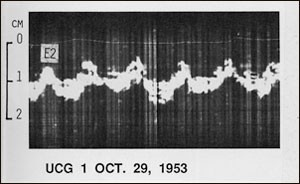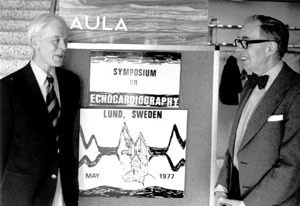Preface
Content is incomplete and may be incorrect. |
| Author | I.A.C. van der Bilt | |
| Moderator | I.A.C. van der Bilt | |
| Supervisor | ||
| some notes about authorship | ||
This open access online echocardiography course and textbook for echocardiography is the second project of the Cardionetworks Foundation.This website is intended for Echotechnicians, Cardiology residents, and as a reference for Cardiologists. All images and movies are licensed under the creative commons license. Please feel free to contact us if you have any comments on how to improve this website. Also, if you can't find things and want us to add something we are very happy to assist you.
History of Echocardiography
It is challenging to find out who exactly were involved in the invention and development of ultrasound in general and echocardiography in particular. Facts are that a Frenchman, Martin Versenne (1588-1648) first estimated the speed of sound, and that in that time the physicist Robert Boyle (1627-1691) first noted that a medium is necessary for sound to travel. A few decades later, Abbe Lazarro Spallanzi (1727-1799) proved that bats use ultrasound to navigate. The first practical use of ultrasound, using the piezoelectric crystal developed by the brothers Pierre Curie and Jacques Curie in 1880, saw light in the the first World War. Sonar was developed to detect enemy ships, and later, in 1929 Sokolov used this 'sonar' to detect flaws in metal. It was this use that developed in a valuable addition to the diagnostic arsenal of the physician. Where in the early years after the second world war patient interview, physical examination and the electrocardiogram were the only tools for the doctor with a cardiological patient, currently, echocardiography has developed to an invaluable tool for diagnosing several cardiac diseases.
Clinical use of echocardiography
In 1946, a French physiotherapist, Dr. Andre Denier, proposed passing ultrasound into the body and recording the waves on an scilloscope wired to display Lissajous images. He thought that all of the internal organs could be visualized in this fashion. Denier failed in constructing his model. An Austrian neurologist, Dr. K.T. Dussik, in collaboration with his physicist brother, succeeded in applying ultrasound in diagnostics for the first time. His idea was to outline the ventricles of the brain and thereby identify various pathologies. His success was very limited, because most of the waves were either absorbed or reflected by the bone in the cranium. He did suggest using the reflected waves, but apparently gave up this idea after being ridiculed. It was the German W.D. Keidel that first used ultrasound to examine volumes of the heart in 1950. But is was not until 1953 that Inge Edler, 42, and Hellmuth Hertz, 36 used a commercial ultrasonoscope borrowed by Siemens to examine the heart. Edler, a cardiologist, described many of the current echos for the first time.He performed ultrasonic examinations on patients who were dying, marking the location and direction of the ultrasonic beam. When the patient died, he stuck an ice pick into the chest in the direction of the beam. At autopsy, he discovered that the beam transected the anterior leaflet of the mitral valve and not necessarily the back wall of theleft atrium. The velocity of movement was low in mitral stenosis, and they could demonstrate improvement after commissurotomy. They even went a step ahead and could detect restenosis in patients after mitral commissurotomy. The vital part of their success was their ability to record oscillations on a paper over time; Dr. Hertz designed inkjet recorders for the purpose. This was the birth of Mmode echocardiography. He was later able to incorporate electrocardiograms simultaneously on the paper, and these M-mode recordings were called ultrasound cardiograms. Dr. Hertz spent the rest of his life working on the inkjet recording technology. Demonstrating atrial clot, a myxoma, and the movement in atrial flutter.
2D Echocardiography
The M-mode of echocardiography was difficult for physicians to understand, and thus its application in clinical practice was limited. The addition of 2-dimensional images to a cardiac ultrasound changed this. Dr. Wild published the first images of a tissue using ultrasound, when he produced echograms of a resected stomach wall with cancer. In 1954, he and Dr. Reid published on the ability of reflected ultrasound to differentiate benign and malignant breast tumors. Reid later teamed up with Dr. Joyner at the Moore School of Electrical Engineering at Philadelphia and developed their own reflectoscope. The reflectoscope had progressed from measuring amplitude (A mode) to measuring brightness (B-mode). Dr. King demonstrated that by recording brightness simultaneously from multiple areas, images of organs could be created. His contribution was called the stop-action image, and this technology remained popular until the linear array transducer was developed by Dr. Bom and colleagues . Using this linear scanner, Dr. Bom and colleagues were able to produce “stunning” real-time images of the heart. This clearly demonstrated the potential of real-time imaging. These linear transducers still are being used in noncardiac ultrasonography. In 1968, Dr. Somer constructed the first electronic phasedarray scanner. Based on this, Drs. Thurstone and von Ramm built a scanner in 1974 that revolutionized the use of ultrasound in clinical cardiology.

